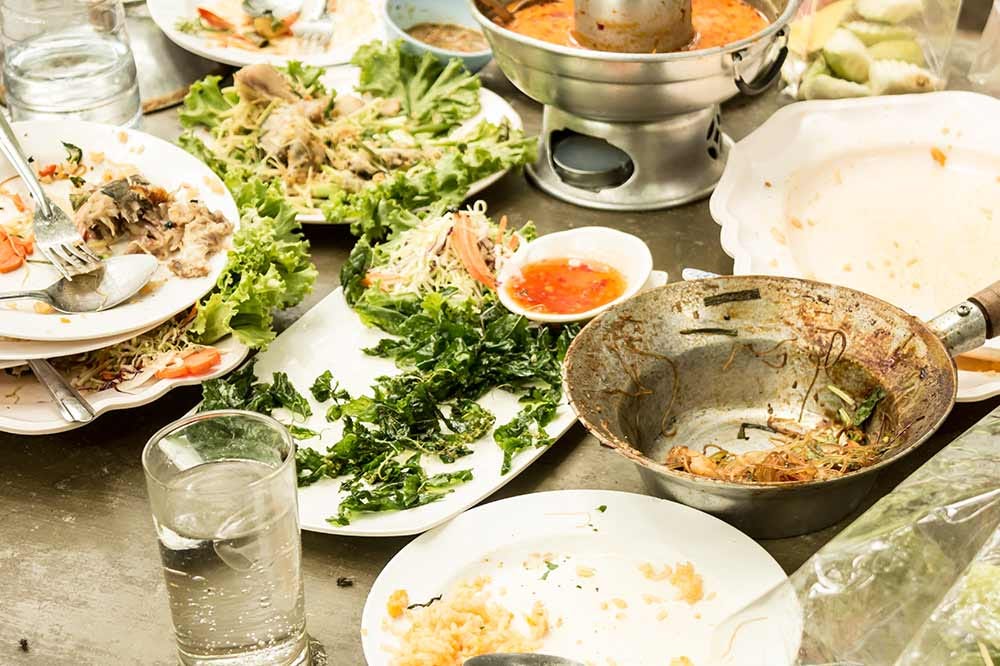Ordering big in restaurants = more pain for the planet
Restaurant food waste is a big problem
“You have ordered well.” The server regarded my wife and me. Then she turned to our dinner partners, saying, “And you have not,”
The four of us had just sat down for Spanish tapas, each of us picking a dish from the menu. By chance, the two plates my wife and I chose turned out to be Goldilocks portions, not too big, not too small. Just right. The tapas ordered by our friends were both huge. Each could have easily filled two diners. With help from the server, our friends found smaller plates, and as I recall, no doggie bags accompanied us home.
What usually happens, however, is the server takes the order, the plates come out loaded from the kitchen, and there is way more food than can be eaten. A lot of times diners don’t bother with doggie bags; they just leave the extra food to be scrapped by the restaurant. In more cases than not, folks pack up the remaining veal parmesan or Peking duck with the full intention of having it for lunch in a couple days, only to dig the box out of the refrigerator three weeks later after the contents have turned into a fuzzy green mess.
We waste a lot of food. The Food and Drug Administration estimates that as much as 30 to 40 percent of our food in the United States is wasted. About 40 percent of that wastage comes from food service, grocery stores, and restaurants. While some of the food goes to waste in the restaurant kitchens, most of it comes from folks ordering too much food.
Wasting food has consequences. All that food is grown, processed, transported, and sometimes refrigerated; all of which take energy and produce greenhouse gasses. The EPA estimates that every year in the U.S. all that waste produces the equivalent of 170 million metric tons of carbon dioxide into the atmosphere. Further, that wasted food is dumped in landfills, where it produces methane, a greenhouse gas 24 times more powerful than carbon dioxide. In 2021, the methane produced by our landfills was equivalent to the greenhouse gases produced by 23 million gas-powered automobiles.
Researchers look into the causes of over-ordering and food waste
Researchers have found that most folks are sensible when they order in restaurants, but social dynamics influence all of us to order more than we can eat. A recent study published in the journal Sustainability found that people will feel a sense of obligation to order less food, thereby reducing food waste, if they are aware of the social and environmental consequences of wasting food. They also found that folks with a stronger sense of morals tended to order less food in restaurants. If servers see customers getting out of a car with a Bernie Sanders sticker on its bumper, they can assume these folks aren’t going to order the 19-inch pizza with the added bread sticks.
On the other hand, they also found that folks feel “pleasant, satisfied, and gratified while ordering more than their appetite warrants, particularly when they have many choices on the menu in social dining.” People will over-order as a way of getting approval from their fellow diners. Folks get excited; their eyes light up when somebody at their table reads off appetizer after appetizer from the menu. It’s also easy to order food in a restaurant; nobody in charge, except perhaps for our Spanish server, will say, “Hey, your party of four will never finish those eleven appetizers.”

As other research has found, waiters can also encourage folks to over-order. Diners can feel comfortable or compelled to follow a waiter’s suggestions, or they want to gain the waiter’s approval. Cynically, we can view waiters encouraging diners to order more food as a strategy to increase the bill and hence their tips. I’m certain this happens at every restaurant during every dining hour. But it’s also true that waiters are just people, and they like to contribute to the joy their customers are experiencing.
Researchers in Korea recently found that face-saving enters into the practice of over-ordering. Folks are afraid of the potential embarrassment of not ordering enough food, so they knowingly order too much. While one person or a couple might comply with social norms of ordering food sensibly, face-saving can override this tendency in a group, and the table becomes loaded with serving dishes. And, big surprise, rich people order way more food all the time to exhibit their affluence or social status.
One study holds promise for mitigating this problem. Everybody who has ordered a burger or frankfurter knows there are almost always way too many French fries. A large order at just about any restaurant is usually a towering pile of deep fried, salted spuds. And one thing that is almost 100 percent universal, when everyone is finished eating, there are usually a lot of fries left over. You might put that remaining half-sandwich or leftover pasta in a doggie bag, but nobody packs up fries. Even the best fries taste like cardboard once they’ve gotten cold.
Researchers in Europe went to a restaurant on a college campus, and over a four-day period, reduced the portion size of a side of fries by 20 percent. The researchers gave questionnaires to students after they had enjoyed their meals. The students reported no difference in satiety, or feeling full when they finished their meals. During those four days, consumption of fries decreased by over nine percent and, more importantly in my eyes, waste of fries decreased by a whopping 66.4 percent.
It’s also encouraging that the National Restaurant Association takes food waste seriously, offering restauranteurs lots os tips, such as offering full and half sized portions and allowing diners to split entrees. How about you? do you try to keep your food orders modest? Or are you likely to take a doggie bag home? Just click the “Leave a comment” button below.
.






Restaurant food is something I struggle with as I have a strong cultural inclination to eat everything and a tendency to put on weight at the slightest over-eating. And I hate food waste. I definitely look for smaller, lighter meals.
Such an important topic! I never realized how much food waste can be linked to social dynamics at the table. It’s easy to over-order when everyone’s excited, but the environmental impact is huge. On a related note, if you’re ever looking for menu inspiration that helps reduce food waste, something like the <a href="https://thedunkindonutsmenu.com/">Dunkin Donuts menu!</a> offers great options for smaller portions that are just right!